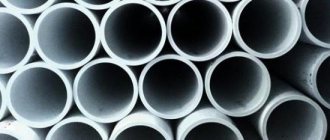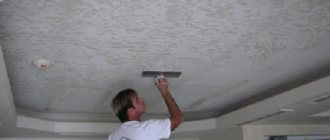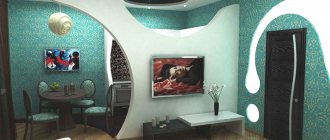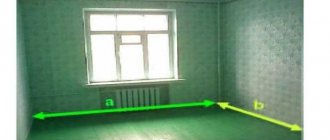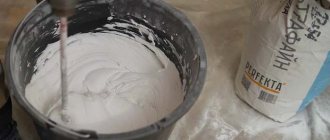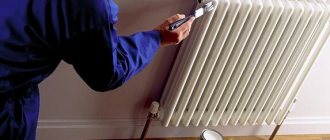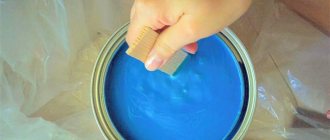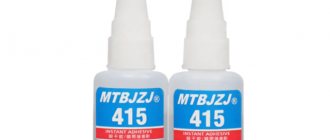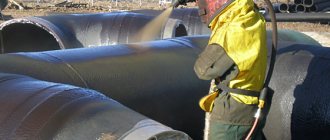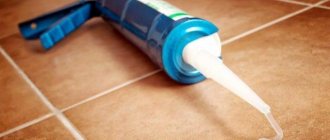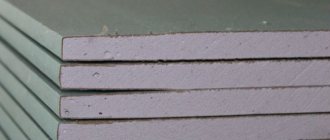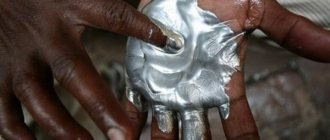Painting pipes is a mandatory procedure, which plays not only an aesthetic role, but also extends the life of the pipeline. Painting work is carried out using consumables such as primer and paint. But how to determine how many of them will be needed so that there is enough and there is no surplus left? This is especially difficult to do when large amounts of work are planned, for example, processing communications at a gas distribution station. To correctly calculate the amount of paint and varnish, you need to know the area to be painted on the pipes. We'll talk about how to calculate it further.
Types of pipes
First of all, it should be taken into account that paint consumption will be affected not only by the size of the pipes, but also by their shape, as well as the structure of the material from which they are made. So, for example, to cover smooth-walled and corrugated products of the same size, different amounts of paintwork materials will be required.
Pipes can have a wide variety of shapes and cross-sectional sizes. Depending on these parameters, the scope of operation of pipe products is determined. The most common pipes are cylindrical in shape with a round cross-section, most often used for the construction of water and gas pipelines.
A popular type of construction metal products are profile pipes with a cross-section different from round. They can be oval, square and rectangular. They are used to create structure frames, various metal structures, floors and spans.
Corrugated pipes with a round cross-section are used for the construction of underground non-pressure domestic and industrial sewerage systems and storm sewers.
There are also cone-shaped pipes. They are intended for pressure injection systems.
The life of a fence begins with the posts
The overall impression of the entire composition enclosing your territory is created, first of all, by the power frame that carries the decorative elements of the structure. It does not matter whether it is a European picket fence, brick or wooden elements. Such a power frame can be created by deciding in favor of one of the following options for fence posts:
Preparation for installation of any of the selected options has its own, only inherent, features. In our recommendations we will focus exclusively on the issues of painting the strength part of the fence. In the apparent simplicity of the issue under consideration, not only the beauty and attractiveness of the external appearance of the structure is hidden, but also its durability.
Measurements
There are two ways to calculate the volume of paints and varnishes: using a special table or using geometric formulas. In both cases, it will be necessary to make accurate measurements of the products.
If there is a table of the area of pipes to be painted, you just need to find a position in it with the same dimensional indicators as obtained during measurements, and look at the consumption of paint or primer. Calculation using formulas is a more complex, but no less effective way. To determine the painting area of pipes of a certain shape and cross-section, the appropriate formulas are used.
Basic points of calculations
If we consider the pipe from the point of view of geometry, then it is nothing more than a simple cylinder.
Therefore, the calculation is carried out using the appropriate formulas. First of all, these calculations can be useful if it is necessary to calculate the heat transfer of any heat exchanger. As a result, it is possible to determine the dimensions of the surface that transfers heat from the coolant. In fact, this value will be the area of the steel pipe to be painted.
It is often necessary to calculate heat loss along the way to an installed heating device. To determine how many radiators or other heating elements will be required for installation, you need to find out how many calories each device that is being considered for installation has. In some cases, a table may be required to make calculating surface area much easier. Thus, it is possible to determine the exact number of heating radiators to ensure adequate heat supply. And if the length of the heating main is several kilometers, then by making an accurate calculation, you can thereby reduce the financial costs of the enterprise.
In this case, everything possible must be done to reduce heat transfer to minimum values. To find out how much heat-saving material to purchase for pipes, you need to calculate the surface area that you need to protect from unwanted heat loss. This is exactly what a table can come in handy for. These calculations allow you to find out the painting area of the profile pipe.
The table below shows the painting area of 1 square meter. m of pipe, depending on the dimensions of the insulating layer:
The surface area to be painted along with the cost of paint consumption per 1 sq. m. allows you to determine a fairly accurate volume of required purchases. In addition, in this case, you can independently determine whether the craftsmen correctly and “honestly” calculated the amount of material required for the repair. For example, if twice as much paint or bitumen varnish is used than was calculated, it means that the remaining amount of material is being used “for other purposes.”
Cylindrical pipes
To make calculations, you need to know the length of the pipe and its outer radius. Length is measured in meters and radius in millimeters. The following formula is used:
S = 2 x π * R x L, where:
- S – pipe area to be painted;
- π – pi number equal to 3.14;
- R – radius;
- L – length.
For example, with a pipe length of 10 m and a diameter of 60 mm, its surface area will be 1.88 square meters. meters.
The same formula is used to calculate the paint area of sewer pipes. The only difference between these designs is their large sizes. For example, the diameter of sewer wells can be 70-200 cm. In such cases, the standard height of these products is taken as a basis - 90 cm.
Corrugated pipes
These types of products are the most difficult to accurately calculate their surface area because they can be stretched lengthwise. For ease of calculations, it is recommended that all values obtained during measurements be presented in writing in the form of a table.
So, you will need to set the following parameters:
- radius of curvature (A);
- projections of smooth parts onto length and diameter (B, D);
- corrugation pitch size (C);
- the angle of inclination of a flat area (E);
- height of the corrugated part (F);
- product pull line (G).
Using a specific example, let's look at how calculations are carried out. For example, value A is 3 mm. To determine the size of the rounded part, the formula 2 x π x A is used. Thus, the result is 18.84 mm. The value of D must be doubled, let it be equal to 20 mm. Taking into account the above data, it is possible to determine the length of the corrugation in stretched form - 38.84 mm.
Having removed the angle of inclination, we calculate the value of E. This indicator will be equal to twice the diameter, that is, 12 mm.
Let's assume that the length of the product is 10 m. To calculate the number of folds, divide the length by the step and get 866 pieces. Next, you need to determine the length of the corrugated pipe in the stretched state. With a diameter of, for example, 52 mm, the total area of the structure will be 54.92 square meters. meters.
Why you may need to calculate surface area
It’s worth starting by listing the main situations in which it may be necessary to calculate the area of pipes, their cross-section or surface.
First of all, the formula by which you can find the area of the pipes can be useful if you need to calculate the heat transfer of a register or a heated floor. Both of these values can be derived precisely from the total area that transfers heat from the coolant to the air in the room.
In order to make the right decision about the number and size of radiators, convectors and other various appliances, you will need to know how many calories the person interested has.
- Quite often the opposite situation can occur, in which it is necessary to calculate heat losses on the way to the heating device. In order to make the right decision about the number and size of radiators, convectors and other various appliances, you will need to know how many calories the person interested has. It can be derived taking into account the surface area of structures that transport water from the elevator unit.
- A table for calculating surface area may be needed in order to purchase the required amount of insulating material. If the length of the heating main is calculated in kilometers (and this is most often the case), with the help of an accurate calculation you can save significant amounts of money for the enterprise.
A table for calculating surface area may be needed in order to purchase the required amount of insulating material.
In this case, it is necessary to reduce heat transfer to a minimum. In order to find out how much heat-insulating material will be needed, you need to know the surface area that you plan to protect from heat loss. A table can help with this.
The cost of paint or anti-corrosion coating can also be included there. The area to be painted on a steel pipe along with the paint consumption per square meter. m can give the exact volume of purchases that will be needed.
In addition, in this case, the misuse of the material will be quite clearly visible. For example, if bitumen varnish or paint is used twice as much as the estimated amount, the company needs to think about stopping theft.
Calculation of the cross-sectional area of the pipes for painting will be needed to find out its maximum permeability. You can install a pipe that is obviously larger than necessary, however, when drawing up a standard project according to which a large number of houses will be built, the cost overrun in such a case will be significantly greater.
It is important to know that paint manufacturers indicate its consumption in grams per 1 square meter. m surface
The larger the surface of the pipe, the more heat will be dissipated on it.
You also need to know that in the case of a private house, the cost overrun if you simply take the pipe one step larger will be small. However, heat losses can increase noticeably. For those people who do not understand why this happens, it is recommended to remember the following: the larger the surface of the pipe, the more heat will be dissipated on it.
In addition, between the moments when the hot water tap is opened, the entire volume in the corresponding water supply will cool down pointlessly.
The larger the diameter of the pipe for painting, the greater the amount of water it will contain, therefore, the more heat will be wasted on aimlessly heating the room.
Selection of paints and varnishes
Different types of paints are used to paint pipes:
- Acrylic enamel, which contains organic solvents, providing a strong and durable glossy finish.
- Alkyd enamel is available for sale in a huge range of colors. Such paints are also characterized by durability, forming a reliable layer that does not crack or wear off.
- Water-dispersion paints. The advantages of such compositions include the ability to dry quickly and the absence of an unpleasant odor. The disadvantages are poor resistance to abrasion and water. Before using water-based paints, pipes must be coated with a primer.
- Oil paint. It is rarely used for painting pipes. Available in a small range of colors. Before painting metal surfaces, including pipes, a primer is required to ensure a strong bond with the paint. An oil-based paint composition is applied to the dried primer in at least two layers.
When choosing the type of paint for painting pipes, it is necessary, first of all, to focus on their purpose and operating conditions, since both the durability of the paint coating and the service life will depend on factors such as temperature, humidity, risk of mechanical damage, etc. service of the pipes themselves.
